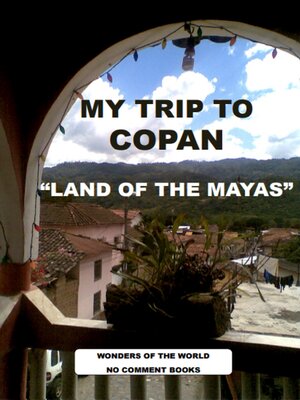
Sign up to save your library
With an OverDrive account, you can save your favorite libraries for at-a-glance information about availability. Find out more about OverDrive accounts.
Find this title in Libby, the library reading app by OverDrive.



Search for a digital library with this title
Title found at these libraries:
| Library Name | Distance |
|---|---|
| Loading... |
MY TRIP TO COPAN
"LAND OF THE MAYAS"
WONDERS OF THE WORLD
NO COMMENT BOOKS
Wonder of the World
The beauty of the old world
The beauty of the old world
Copán is an archaeological site of the Maya civilization it lies within the municipality of Copán Ruinas in the department of Copán., not far from the border with Guatemala. This ancient Maya city mirrors the beauty of the physical landscape; it is in a fertile valley among foothills at 700 meters (2,300 ft) above mean sea level. The ruins of the site core of the city are 1.6 kilometers (1 mi) from the modern village of Copán Ruinas, which is built on the site of a major complex dating to the Classic period.
Copán was occupied for more than two thousand years. The city developed a distinctive sculptural style within the tradition of the lowland Maya, perhaps to emphasize the Maya ethnicity of the city's rulers. It was the capital city of a major Classic period kingdom from the 5th to 9th centuries AD. The city was in the extreme southeast of the Mesoamerican cultural region, on the frontier with the Isthmo-Colombian cultural region.
As one of the most important sites in Mayan history, and because of its outstanding, well-preserved architecture, Copán was declared a UNESCO World Heritage Site in 1980, and the site was designated a cultural monument by the Honduran Government in 1982.
The city has a historical record that spans the greater part of the Classic period and has been reconstructed in detail by archaeologists and epigraphers. Copán was a powerful city ruling a vast kingdom within the southern Maya area. The city suffered a major political disaster in AD 738 when one of the greatest kings in Copán's dynastic history, was captured and executed by his former vassal, the king of Quiriguá. This unexpected defeat resulted in a 17-year hiatus at the city, during which time Copán may have been subject to Quiriguá in a reversal of fortunes.
A significant portion of the eastern side of the acropolis was eroded away by the Copán River; the river has since been diverted to protect the site from further damage.
Copán had a major influence on regional centers across western and central Honduras, stimulating the introduction of Mesoamerican characteristics to local elites.
The area of Copán continued to be occupied after the last major ceremonial structures and royal monuments were erected, but the population declined in the 8th and 9th centuries from perhaps over 20,000 in the city to less than 5,000. This decrease in population took over four centuries to actually show signs of collapse, showing the stability of this site even after the fall of the ruling dynasties and royal families. The ceremonial center was long abandoned and the surrounding valley home to only a few farming hamlets at the time of the arrival of the Spanish in the 16th century.







